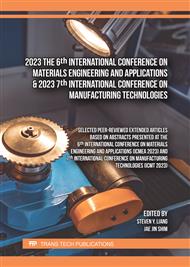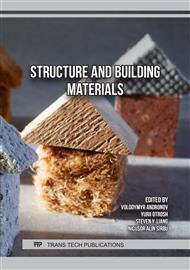[1]
A. Zahedi, L. F. M. Sanchez, M. Noël, Appraisal of visual inspection techniques to understand and describe ASR-induced development under distinct confinement conditions, Construction and Building Materials, Volume 323, (2022), 126549, ISSN 0950-0618, Available:.
DOI: 10.1016/j.conbuildmat.2022.126549
Google Scholar
[2]
P. Venyite, J. G. D. Nemaleu, R. C. Kaze, A. B. Tchamba, E. Kamseu, U. C. Melo, C. Leonelli, "Alkali-silica reactions in granite-based aggregates: The role of biotite and pyrite, Construction and Building Materials," Volume 320, 2022.
DOI: 10.1016/j.conbuildmat.2021.126259
Google Scholar
[3]
R.B. Figueira, R. Sousa, L. Coelho, M. Azenha, J.M. de Almeida, P.A.S. Jorge, C.J.R. Silva, Alkali-silica reaction in concrete: Mechanisms, mitigation and test methods, Construction and Building Materials, Volume 222, (2019), Pages 903-931, ISSN 0950-0618, Available:.
DOI: 10.1016/j.conbuildmat.2019.07.230
Google Scholar
[4]
A.K. Saha, Ashish & Khan, Md Nabi Newaz & Sarker, Prabir & Shaikh, Faiz & Pramanik, A. The ASR mechanism of reactive aggregates in concrete and its mitigation by fly ash: A critical review. Construction and Building Materials. 171. 743-758. (2018).
DOI: 10.1016/j.conbuildmat.2018.03.183
Google Scholar
[5]
A. Rutkauskas et al., "Cement Type Influence on Alkali-Silica Reaction in Concrete with Crushed Gravel Aggregate." IOP Conf. Ser.: Mater. Sci. Eng. 251 012032, 2017.
DOI: 10.1088/1757-899x/251/1/012032
Google Scholar
[6]
M. Zhang, W. Zhang & F. Xie, Experimental study on ASR performance of concrete with nano-particles, Journal of Asian Architecture and Building Engineering, (2019), 18:1, 2-8
DOI: 10.1080/13467581.2019.1582420
Google Scholar
[7]
A. Gholizadeh-Vayghan, F. Rajabipour, "The influence of alkali-silica reaction (ASR) gel composition on its hydrophilic properties and free swelling in contact with water vapor." Cement and Concrete Research (2017) 94:49–58
DOI: 10.1016/j.cemconres.2017.01.006
Google Scholar
[8]
A.Gholizadeh-Vayghan, F. Rajabipour, "Quantifying the swelling properties of alkali-silica reaction (ASR) gels as a function of their composition." Journal of the American Ceramic Society (2017) 100(8):3801–3818
DOI: 10.1111/jace.14893
Google Scholar
[9]
F.M. Maia Neto, T.W.C.O. Andrade, R.M. Gomes, A.F. Leal, A.N.F. Almeida, M.R.F. Lima Filho, S.M. Torres, "Considerations on the effect of temperature, cation type and molarity on silica degradation and implications to ASR assessment, Construction, and Building Materials," 2021.
DOI: 10.1016/j.conbuildmat.2021.123848
Google Scholar
[10]
T. Iskhakov, J.J. Timothy, G. Meschke, Expansion and deterioration of concrete due to ASR: Micromechanical modeling and analysis, Cement and Concrete Research, 115 (2019), pp.507-518
DOI: 10.1016/j.cemconres.2018.08.001
Google Scholar
[11]
Y. Kawabata, J.-F. Seignol, R.-P. Martin, F. Toutlemonde Macroscopic chemo-mechanical modeling of alkali-silica reaction of concrete under stresses, Constr. Build. Mater., 137 (2017), pp.234-245
DOI: 10.1016/j.conbuildmat.2017.01.090
Google Scholar
[12]
W. Wallau, S. Pirskawetz, K. Voland, B. Meng, Continuous expansion measurement in accelerated concrete prism testing for verifying ASR-expansion models Mater. Struct., 51 (2018) 10.617/s11527-018-1205-0
DOI: 10.1617/s11527-018-1205-0
Google Scholar
[13]
D. Luo, A. Sinha, M. Adhikari, J. Wei, Mitigating alkali-silica reaction through metakaolin-based internal conditioning: New insights into property evolution and mitigation mechanism, Cement and Concrete Research, Volume 159,2022, 106888, ISSN 0008-8846.
DOI: 10.1016/j.cemconres.2022.106888
Google Scholar
[14]
F. Zunino, K. Scrivener, Increasing the kaolinite content of raw clays using particle classification techniques for use as supplementary cementitious materials, Constr Build Mater (2020) 244:118335.
DOI: 10.1016/j.conbuildmat.2020.118335
Google Scholar
[15]
C. Lu, S. Bu, M. Shahin, Y. Zheng, L. Cheng, Mitigation of alkali-silica reaction by microbially induced CaCO3 protective layer on aggregates, Construction and Building Materials, Volume 328, 2022, 127065, ISSN0950-0618, https://doi.org/10.1016/j.conbuildmat.2022. 127065.
DOI: 10.1016/j.conbuildmat.2022.127065
Google Scholar
[16]
Y. Wang, L. Burris, C. R. Shearer, D. Hooton, P. Suraneni, Strength activity index and bulk resistivity index modifications that differentiate inert and reactive materials, Cem Concr Compos (2021) 124:104240.
DOI: 10.1016/j.cemconcomp.2021.104240
Google Scholar
[17]
H. Konduru, P. Rangaraju, O. Amer, Reliability of miniature concrete prism test in assessing alkali-silica reactivity of moderately reactive aggregates, Transp. Es. Rec., 2674 (2020), pp.23-29
DOI: 10.1177/0361198120912247
Google Scholar
[18]
R.A. Deschenes Jr, E.R. Giannini, T. Drimalas, B. Fournier, W.M. Hale, mitigating alkali-silica reaction and freezing and thawing in concrete pavement by Silane treatment, ACI Mater. J., 115, 2018.
DOI: 10.14359/51702345
Google Scholar
[19]
K.L. Scrivener, V.M. John, E.M. Gartner, Eco‐efficient cement: Potential economically viable solutions for a low‐CO2 cement-based materials industry. Cem Concr Res (2018) 114:2‐26
DOI: 10.1016/j.cemconres.2018.03.015
Google Scholar
[20]
H. Wang, J.E. Gillott, Mechanism of alkali-silica reaction and the significance of calcium hydroxide, Cem. Concr. Res., 21 (1991), pp.647-654
DOI: 10.1016/0008-8846(91)90115-x
Google Scholar
[21]
Y. Kawabata, K. Yamada, The mechanism of limited inhibition by fly ash on expansion due to alkali-silica reaction at the pessimum proportion, Cem. Concr. Res., 92 (2017), pp.1-15
DOI: 10.1016/j.cemconres.2016.11.002
Google Scholar
[22]
A. Joshaghani, the effect of trass and fly ash in minimizing alkali-carbonate reaction in concrete, Constr. Build. Mater., 150 (2017), pp.583-590
DOI: 10.1016/j.conbuildmat.2017.06.034
Google Scholar
[23]
S. Al-Shmaisani, R. Kalina, K. O'Quinn, J.K. Jang, M. Rung, R. Ferron, M. Juenger, Supplementary Cementitious Materials: Assessment of Test Methods for New and Blended Materials, Ph.D. dissertation, the University of Texas at Austin (2020).
DOI: 10.1520/acem20210149
Google Scholar
[24]
M. Kasaniya, M.D.A. Thomas, E.G., Moffatt, Efficiency of natural pozzolans, ground glasses and coal bottom ashes in mitigating sulfate attack and alkali‐silica reaction, Cem Concr Res (2021) 149:106551
DOI: 10.1016/j.cemconres.2021.106551
Google Scholar
[25]
M. C. G. Juenger, R. Snellings, S. A. Bernal, Supplementary cementitious materials: New sources, characterization, and performance insights, Cem Concr Res (2019) 122:257‐273.
DOI: 10.1016/j.cemconres.2019.05.008
Google Scholar
[26]
V. P. Sopoev, O. I. Korkih, and M. Y. Izbarsh, A study of the alkali-silica reaction in recycled glass concrete IOP Conf. Ser. Mater. Sci. Eng. 907, 2020.
DOI: 10.1088/1757-899x/907/1/012062
Google Scholar
[27]
L.M.S. Souza, R.B. Polder, O. Çopuroğlu, Lithium migration in a two-chamber set-up as a treatment against expansion due to alkali-silica reaction, Constr. Build. Mater., 134 (2017), pp.324-335
DOI: 10.1016/j.conbuildmat.2016.12.052
Google Scholar
[28]
Z. Shi, C. Shi, J. Zhang, S. Wan, Z. Zhang, Z. Ou, Alkali-silica reaction in water glass-activated slag mortars incorporating fly ash and metakaolin, Cem. Concr. Res., 108 (2018), pp.10-19
DOI: 10.1016/j.cemconres.2018.03.002
Google Scholar
[29]
Standard Practice for Petrographic Examination of Hardened Concrete A. C856-18a, 2018.
Google Scholar
[30]
ASTM C1260 (2007) Standard test method for potential alkali reactivity of aggregates (mortar-bar method). ASTM International, West Conshohocken, PA, USA.
DOI: 10.1520/c1260-05
Google Scholar
[31]
R. Snellings, X. Li, F. Avet, K. Scrivener, Rapid, robust, and relevant (R3) reactivity test for supplementary cementitious materials, ACI Mater J (2019) 116:155‐162
DOI: 10.14359/51716719
Google Scholar
[32]
J. Liaudat, I. Carol, C.M. López, A. Leemann, ASR expansions at the level of a single glass-cement paste interface: experimental results and proposal of a reaction-expansion mechanism, Construction and building materials, 218 (2019), pp.108-118
DOI: 10.1016/j.conbuildmat.2019.05.106
Google Scholar
[33]
ASTM C1260 (2014) Standard test method for potential alkali reactivity of aggregates (mortar-bar method). ASTM International, West Conshohocken, PA, USA.
DOI: 10.1520/c1260-94
Google Scholar
[34]
Soil Survey of Davao Province. Bureau of Soil Water Management. Accessed Dec. 03, 2021.
Google Scholar
[35]
D. Zollinger, A. Mukhopadhyay, H. Ghanem C.-S. Shon, D. Gress, and D. Hooton, Mitigation of ASR in Concrete Pavement-Combined Materials Testing: Innovative Pavement Research Foundation, 2009.
Google Scholar
[36]
ASTM, C1293: Standard test method for determination of length change of concrete due to Alkali-Silica Reaction. ASTM International, West Conshohocken, PA (2018)
Google Scholar
[37]
W.J. Phillips, Alkali-Silica Reaction Mitigation Using High Volume Class C Fly Ash, University of Arkansas, Arkansas, (2015)
Google Scholar
[38]
A.G. Vayghan, J.R. Wright, F. Rajabipour, an extended chemical index model to predict the fly ash dosage necessary for mitigating alkali-silica reaction in concrete, Cement and Concrete Research Vol. 82, 2016, p.1–10.
DOI: 10.1016/j.cemconres.2015.12.014
Google Scholar



